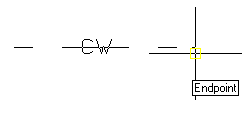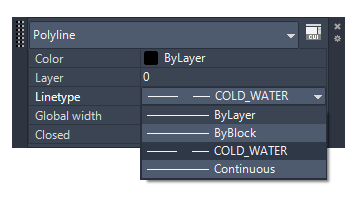Creates a linetype definition based on selected objects and stores them in a specified linetype definition (LIN) file.
A linetype is a repeating series of dashes, dots, shapes, and text objects. With the standard AutoCAD PLINE, LINE, POINT, TEXT, and SHAPE commands, draw an approximation of your linetype; then select the objects at the Select Objects prompt in MKLTYPE. You can define both complex and simple linetypes with MKLTYPE. To define a complex linetype, include shape or text objects in your selection. With MKSHAPE you can create shapes simply by selecting objects.
Command: MKLTYPE
Select a ".LIN" file: <C:\Express\Drawings\acad.lin>: Enter a linetype file name and folder path
Enter linetype name: Specify a linetype name
Linetype description: Specify a linetype description
Starting point for line definition: Specify a starting point
Ending point for line definition: Specify an ending point
Select objects: Select a line, polyline, point, shape, or text object
Notes
- If you select an existing LIN file, the File dialog box warns you that the file will be replaced; however, the file is actually appended to. If you choose to create a linetype with the same name as one that already exists in the selected LIN file, an overwrite warning appears. If you choose yes, the existing linetype is overwritten, but the rest of the file remains intact.
- If you try to create a linetype that begins with an empty segment, the program adds a dot to the beginning of the definition.
- Polylines created with complex linetypes display shapes better if you set PLINEGEN to 1 in some circumstances.
- If you create a complex linetype with shapes, you can select only the shapes that lie in the XY plane of the current UCS and are not mirrored.
Example
Create a dashed cold water linetype.
After specifying the file name, linetype name and description, select points to show the start points and end points for line definition:

Specify the line and text objects to be used to define the linetype:

The linetype is loaded and is ready to use:

File
mkltype.lsp
